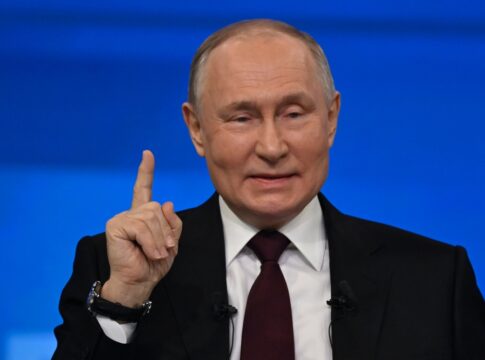In the midst of growing tensions between Trump and Putin on multiple fronts, the U.S. Air Force employs specialized reconnaissance aircraft to monitor Russian military activities near NATO borders. The reconnaissance mission takes place as tensions between Russia and the US over Ukraine are rising and there is a chance that the US will take military action against Iran. A recent lengthy phone call between President Trump and President Putin regarding the conflicts in the Middle East and Ukraine revealed clear differences.
Resume for Strategic Intelligence Operations
After being stationed in the Middle East for several months, a U.S. Air Force RC-135V Rivet Joint aircraft has resumed intelligence-gathering missions toward Russia. The specialized reconnaissance aircraft, designated “JAKE17,” took off from a British Royal Air Force base and carried out surveillance missions close to Kaliningrad, Russia’s strategically significant exclave in the Baltic Sea. The plane flew over Europe, passing through NATO members Estonia, Latvia, and Lithuania—all of which share borders with Russia—to reach Finland.
Increased tensions between Washington and Moscow on several fronts coincide with the timing of this renewed surveillance activity. The RC-135V Rivet Joint can intercept, identify, and geolocate signals across the electromagnetic spectrum, making it ideal for electronic intelligence gathering. These capabilities enable U.S. forces to stay informed about Russian military communications and movements in the vicinity of NATO’s eastern flank.
'WHAT THE HELL?' @realDonaldTrump unloads on Putin after Russia’s biggest air assault yet — says he’s “not happy” with the Russian leader and accuses him of “killing a lot of people.” pic.twitter.com/YDvlnTX32d
— Fox News (@FoxNews) May 26, 2025
Tension in Trump-Putin Relations
Despite earlier hopes for better bilateral relations, recent events have strained the relationship between Presidents Trump and Putin. Significant differences between the two leaders regarding Ukraine and the Middle East were brought to light during a recent long phone conversation. Tensions are still high over Russia’s war in Ukraine and possible U.S. military action against Iran, a major Russian ally, according to statements from both sides.
Previously, between 2017 and 2019, the Trump administration implemented 52 different policy measures against Russia, including sanctioning cybercrimes, election meddling, and military aggression. Trump has hinted at possible changes in U.S. policy, but the current administration seems to be sticking to its guns vis-à-vis Moscow, especially in Ukraine. Despite diplomatic efforts, the placement of intelligence resources close to Russian borders indicates ongoing vigilance.
'WHAT THE HELL?' @realDonaldTrump unloads on Putin after Russia’s biggest air assault yet — says he’s “not happy” with the Russian leader and accuses him of “killing a lot of people.” pic.twitter.com/YDvlnTX32d
— Fox News (@FoxNews) May 26, 2025
Russia-U.S. Relations Are Complicated by the Iran Crisis
A potential U.S. military action against Iran has become a new flashpoint in U.S.-Russia relations. Trump has demanded Iran’s “unconditional surrender” and reportedly considered strikes against the country’s nuclear facilities. Russia, which maintains close ties with Tehran, has warned strongly against such actions, with Russian officials predicting catastrophic consequences for regional stability if the U.S. launches attacks.
The Russia-Iran relationship has strengthened considerably since the outbreak of the Ukraine war, with Iran providing military support to Russia, including drones used against Ukrainian targets. This alliance complicates U.S. strategic calculations in both regions. Russian officials have requested an emergency UN Security Council meeting on the Middle East conflict and positioned themselves as potential mediators, though they are unlikely to intervene militarily if the U.S. strikes Iran.
Effects on the Eastern Flank of NATO
The resumption of RC-135V Rivet Joint missions near Russian territory reflects growing concerns among NATO’s eastern members about potential Russian aggression. Countries like Estonia, Latvia, Lithuania, and Finland have expressed increased anxiety about their security following Russia’s invasion of Ukraine. The U.S. intelligence flights serve both practical reconnaissance purposes and demonstrate continued American commitment to NATO’s collective defense principles.
“I like to make the final decision one second before it’s due.” —Trump
With Trump signaling potential shifts in U.S. policy toward Ukraine and NATO more broadly, these reconnaissance operations provide tangible reassurance to allies concerned about American commitment. The flights also give U.S. military planners critical intelligence on Russian military posture, capabilities, and potential threatening activities in the region. As geopolitical tensions continue to evolve, these intelligence-gathering missions will likely remain a key component of America’s strategic posture in Europe.


